Midweek Review
Breaking the Cocoon: The Duality and Unity of a Dancer’s Body
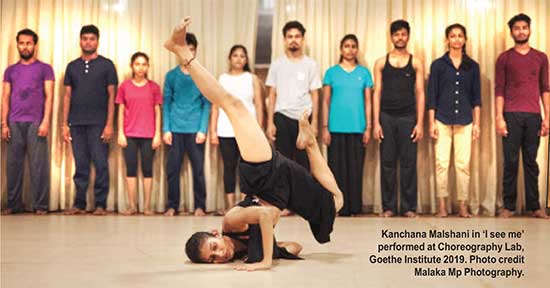
By Dr Saumya Liyanage
Dance is an elusive art form. It is elusive in the sense that any type of dance form uses the human body as its expressive tool, and the art and the artist are one and the same. Dance is in a way similar to the actor’s art because the dancer uses her body as the means of expression. The actor and the dancer share this common ground where their art and the artistic tool are nonetheless inseparable and tightly intertwined. In order to understand the meaning of dance, one may need to separate the dancer’s body from dance but as stated the inseparability of the dancer from dance poses ontological questions as to who the dancer is and what dance is. Therefore, marking a boundary between the body and the work of dance is always blurred.
It is difficult to explain why people dance and how dance is differentiated from non-dance. Celeste Snowber writes that whether we dance and move our bodies, or whether our bodies are static and still, we always dance. She further argues that ‘we are all dancing and as we are all living, whether it is walking or running, swimming or hopping, jumping or being still. There is a dance of blood and fluid circulating in our bodies, and the expressivity of gestures is a daily activity’ (Snowber cited in Leavy, 2018, p. 247). In this analysis, Snowber broadly defines and blurs the distinction between dance and non-dance challenging us to rethink the way we define dance in the contemporary context.
Yet, Sri Lankan dance scholarship is still practised and confined within a particular school of thought that favours dance as a refined, codified body of movement. The learning of dance needs assiduous practice and dedication under a specific training regimen. Moreover, the dancer’s body should be physically trained and aesthetically beautiful to be able to perform and bring meanings to spectators. Hence traditional dance training and performance is purely cultivated through guru-shishya parampara (Teacher-disciple model) where the repetition and execution of learnt scores are supremely important. Very little space is allowed for the novice to explore physical possibilities beyond the regimented body. However, I am not skeptical about the skills and capacities that a traditional dancer possesses. Yet, this long assiduous practice and the regimentation of bodies along with cosmic teaching pertaining to demons and deities would undoubtedly affect and discipline not only the learner’s physicality but their thought process as well. Therefore, these pedagogical systems do not allow the learner to explore various expressions or movement culture.
In this article, I am going to discuss about an emerging dancer and choreographer Kanchana Malshani and her recent work titled, Talking Silambu performed, at the Royal Taprobanian cultural hub in Navinna, Maharagama. In this piece of dance work, Kanchana raises several questions worthy of discussion through the current practice of dance pedagogy in Sri Lanka and ontological questions of what dance is, and who a dancer is. Further her work explores how dance can be a self-exploratory journey for those who seek alternative avenues through breaking their links to traditional forms and regimented bodies.
Kanchana
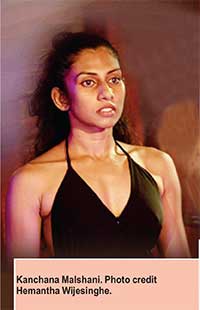 Kanchana Malshani has studied traditional Sri Lankan dance forms from various teachers since her childhood until she graduated from university. Kanchana is a graduate from Sripalee campus, University of Colombo and received a First Class honours degree. Being a student of traditional Sri Lankan dance forms such as Kandyan, Sabaragamuwa and Low country dance, Kanchana has developed her own style through her engagement with contemporary and experimental Sri Lankan dancers such as Venuri Perera and Umeshi Rajeendra. Learning and working with Venuri Perera and her influence on Kanchana’s reincarnation as a contemporary dancer is immense; in her ‘second life’ as a choreographer and dancer, she is being mentored by Venuri Perera. Her recent incarnation as a contemporary dancer signifies that she as a dancer needs a different life and expression within dance scholarship. Her recent work, Talking Silambu, shows a clear rebellious individuality that seeks to break the traditional codification and rebirth as a free bodied woman.
Kanchana Malshani has studied traditional Sri Lankan dance forms from various teachers since her childhood until she graduated from university. Kanchana is a graduate from Sripalee campus, University of Colombo and received a First Class honours degree. Being a student of traditional Sri Lankan dance forms such as Kandyan, Sabaragamuwa and Low country dance, Kanchana has developed her own style through her engagement with contemporary and experimental Sri Lankan dancers such as Venuri Perera and Umeshi Rajeendra. Learning and working with Venuri Perera and her influence on Kanchana’s reincarnation as a contemporary dancer is immense; in her ‘second life’ as a choreographer and dancer, she is being mentored by Venuri Perera. Her recent incarnation as a contemporary dancer signifies that she as a dancer needs a different life and expression within dance scholarship. Her recent work, Talking Silambu, shows a clear rebellious individuality that seeks to break the traditional codification and rebirth as a free bodied woman.
In 2017, Goethe Institute organised a Choreography Lab with dancer Venuri Perera, in Kalpitiya Sri Lanka. At this particular dance lab, Kanchana learnt contemporary dance from Yuko Kaseki, a Japanese Bhuto dancer, and Mahesh Umagiliya. Further, she learnt from Prof. Sandra Mathern-Smith, Professor of dance at Denison University, the USA, who has travelled several times to Sri Lanka as a Fulbright scholar. Her intervention in popularising and mentoring Sri Lankan dancers included a group of students at the University of the Visual and Performing Arts, Colombo, Sripalee campus, was also a turning point in her dance career. Dance teachers like Deepak Kurki Shivaswamy, Preethi Athreya, Maria Colusi have also helped Kanchana develop her skills. After receiving a half scholarship to visit a two-week-long dance camp at Sanskar Dance Festival India, she has been able to work with teachers such as Vittoria de Ferrari Sapetto and Roberto Olivan. Apart from her dance training, Kanchana has been working with one of the English Theatre companies, Stages Theatre, led by writer and director Ruwanthie De Chickera in Colombo. Kanchana may have undoubtedly learnt the value of being an artiste and professionalism in theatre through working in an actors’ ensemble at Stages Theatre.
Dance and Contemporaneity
 The term ‘contemporary dance’ signifies specific meanings to dance specialists than non-specialists of dance. There are certain qualities that set contemporary dance apart from other genres. Contemporary dance can be distinguished from modern and other forms of dance because of its shift from the traditional narratology, dancer’s perspective, and breaking away from some of the dance prejudices to integrate text, words, digital and intermedial elements to it. One such difference is that contemporary dance work departs from traditional third person singular narrative to first person singular self-expression. This first person perspective allows the dancer to reflect her own auto-biographical material.
The term ‘contemporary dance’ signifies specific meanings to dance specialists than non-specialists of dance. There are certain qualities that set contemporary dance apart from other genres. Contemporary dance can be distinguished from modern and other forms of dance because of its shift from the traditional narratology, dancer’s perspective, and breaking away from some of the dance prejudices to integrate text, words, digital and intermedial elements to it. One such difference is that contemporary dance work departs from traditional third person singular narrative to first person singular self-expression. This first person perspective allows the dancer to reflect her own auto-biographical material.
Yet, these auto-ethnographic or auto-biographical narratives finally gets transformed into a political idiom.
Further contemporary dance deconstructs the aesthetic body celebrated in traditional dance and questions and dissects the skin of the dancer by opening up the inner flesh of the body. André Lepecki further identifies the uniqueness of contemporary dance from other genres because of its ‘ephemerality, corporeality, precariousness, scoring, and performativity’ (Kwan, 2017, p. 39). Thus, contemporary dance does not stick to a particular form, style or a structure. Instead it integrates various techniques, styles, and influences even from traditional dance forms to use the body as a political tool and the self as the centre of expression.
Talking Silambu
In this dance work titled, Talking Silambu, a twenty minute long piece of choreography, Kanchana appears in a non-traditional lose attire while wearing two Silambu (Silambu is a type of anklet made out of brass which Kandyan dancers wear when they perform) In the first instance, we hear the sound of Silambu as Kanchana’s legs begin to move. Yet, her dance body starts movement towards the audience while mixing traditional Kandyan dance codification with free body movement. It is clear that she performs half Kandyan and half improvised body movements in the score. In other words, her body movements are choreographed through semi-Kandyan codification mixed with free style movements. When the dance intensifies, she removes her Silambu, holding them in her hands and begins to shake them with vigorous body movements while throwing her body in various directions. At this point, Kanchana uses a trans-like act depicting trans-performance inherited particularly in low country devil dance. In this work, it is clearly demonstrated that her body is struggling with Silambu and trying to remove its connection to the body. This struggle culminates in the final phase of the dance work by indicating she runs away from the codified body and becomes a free woman. In this work, Kanchana demonstrates her discontent with the previous life as a traditional dancer and her struggle to break her affinity to the codified structure and beautification of the body in Kandyan dance. In a short conversation I had with Kanchana, she mentioned as particular rebirth that occurred at a dance camp organised by the Goethe Institute Colombo:
“I have been trained as a traditional dancer since my childhood but for the first time, working with this Japanese Butoh dancer, Yuko Kaseki, I learnt how to speak from my body. For many years I was living in a cage-tradition where I was entrapped. Living in this cage, I have performed what others wanted me to do. But in this dance lab, I found myself speaking to my own body and speaking through the body. I don’t want my body to be beautiful and aesthetically refined. I don’t want to display precision and codification of my body. I want to show how ugly I am and how vulnerable my body is.” (Kanchana, M., Pers. Comm. Dec. 2020).
Against the grain
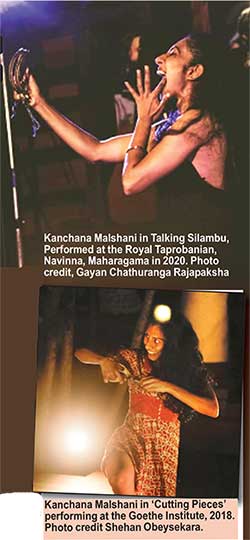 In the traditional dance pedagogy, the dancer’s body is understood as a vehicle via which the dancer’s symbolic meanings are conveyed. There is a clear division between the inner and outer faculties in the dance body, and the dancer’s role is to bring forth those inner feelings to the onlooker via her body movements. This conceptualisation of the dancer’s body as a split between inner and outer is a complex issue pertaining to dance. Knowingly or unknowingly the dancer divides her body into body and mind and this Cartesian division has influenced the dancer to theorise the body and her craft.
In the traditional dance pedagogy, the dancer’s body is understood as a vehicle via which the dancer’s symbolic meanings are conveyed. There is a clear division between the inner and outer faculties in the dance body, and the dancer’s role is to bring forth those inner feelings to the onlooker via her body movements. This conceptualisation of the dancer’s body as a split between inner and outer is a complex issue pertaining to dance. Knowingly or unknowingly the dancer divides her body into body and mind and this Cartesian division has influenced the dancer to theorise the body and her craft.
Living in an ocular centric world, the dancer’s outer body is a place where womanhood is exploited for commercial purposes. From state-sponsored national festivals to television advertisements selling instant noodles or carbonated drinks, the dancer’s outer skin is commodified. Writing about Sri Lankan neo-dance traditions, propagated and performed at high profile delegations, product launches and in TV commercials in the country, I have written elsewhere that ‘women’s bodies succumb to the surgical knife of the choreographer whose male sexual desires are displayed on those bodies. Hence, no difference can be made between a choreographer and a cosmetic surgeon, whose expertise on women’s bodies, especially breasts and buttocks, are surgically transplanted and enhanced by incisions, stitches and staples’ (Liyanage, 2016). Amidst this commodification of female bodies in Sri Lankan dance arena, Kanchana’s attempt is to break away from this commodified, sexualised, and mechanised body to establish a non-codified and unified body of self-expression.
Here it is important for contemporary dancers to understand the value of the ‘living body’ or the ‘lived’ body that is celebrated in the vast literature of phenomenology and dance theory in the contemporary dance literature. In the dominant dance cultures from stage performances to digital and visual representations, the dancer’s skin is the most valued and emphasised. Now, with the contemporary dance turn, the dancer’s living or lived experience has come forth. Kanchana as a dancer now understands that her body is not a place for others to communicate vague meanings but a living entity where her own selfhood is reflected and displayed. It is a challenge for a dancer like her because the dominant female body has already been already established by key dance authors of the country. These dance authors have created a symbolic and sexualised female body for live and digitised performances. This symbolic and sexualised female body consists of the idealised female body for the male viewer. Kanchana is challenging this idealised body that is dominant in the real and digital world.
Dancer and Danced
The key juncture where the lived body differs from the symbolic body is that the symbolic body that is propagated in the media and elsewhere is the body that is not presented as a place for knowledge. Let me explain this further. In the traditional dance pedagogy, the dancer’s body is a place where meanings are generated and shared. In other worlds, the codified body is a canvas or a display where the onlooker extricates meanings. This codified, symbolic body is not presented to us as a place for knowing or sensing. Kanchana’s work and the work of other contemporary dancers suggest that we should understand the body as a place of sensing and knowing. This marks an epistemological turn in dance making and its reception. Dance, or the dancer’s body, has not been considered a place for ‘knowing’ in Sri Lankan dance pedagogy. Most often, a dancer narrates someone’s story or represents a third person singular perspective of the dance.
What Kanchana and the contemporary dance body suggest is to make a shift from the third person singular narrative to a first person singular perspective. This ‘I’ or the first person perspective allows the dancer to narrate her own stories and engagement with the social, cultural and political terrains. Further, a dancer as the author of her own work marks the departure of the dancer as an employer for a particular author. What Kanchana does in Talking Silambu is that as a dancer she tries to incarnate herself and narrate a story of searching a breakthrough and liberation. In this performance, her body works as a site of struggle and seeks the unity of her body and soul.
Conclusion
Understanding the body as a sensing and perceiving entity is still an alien concept to dance pedagogies in universities and private schools. Furthermore, dance can be a self-expressive and auto-ethnographic inquiry and is also a far-reaching idea for our students. Hence, the mainstream dance pedagogy produces dancers who dance without self-motivation to satisfy the audience who come to see symbolic representation of the body. Yet a handful of dancers who are eagerly exploring other avenues for dance expressions are also facing complex issues that their artistic interventions are not fully accepted in the mainstream dance scholarship in the country. Moreover, dancers like Kanchana have chosen a non-popular pathway to pursue their future dance careers and already faced deadlocks, as their artistic practices are not being accepted or sustained by institutions or organisations. Yet Kanchana is determined to break her cocoon to be incarnated as a hybrid moth.
Acknowledgements
The author wishes to thank Himansi Dehigama and Sachini Senevirathe for their assistance in preparing this paper. Further the author’s gratitude goes to dancer Kanchana Malshani.
References
Kwan, S. (2017). When Is Contemporary Dance? Dance Research Journal, [online] 49(3), pp.38–52. Available at: https://www.cambridge.org/core/journals/dance-research-journal/article/when-is-contemporary-dance/8D44743A01A1ECC8100C5E65C1142DC2 [Accessed 4 Oct. 2019].
Leavy, P. (2019). Handbook of arts-based research. New York: The Guilford Press.
Features
Handunnetti and Colonial Shackles of English in Sri Lanka
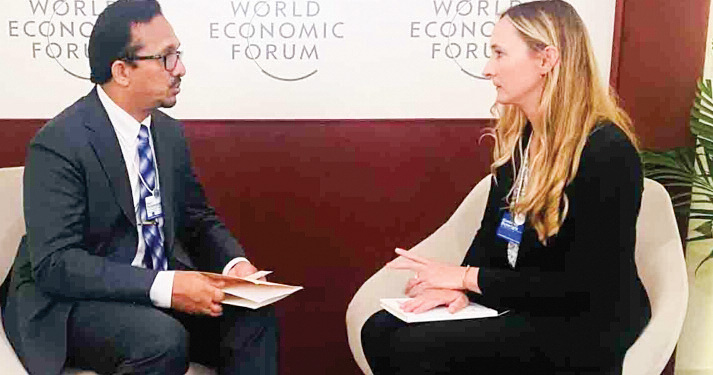
“My tongue in English chains.
I return, after a generation, to you.
I am at the end
of my Dravidic tether
hunger for you unassuaged
I falter, stumble.”
– Indian poet R. Parthasarathy
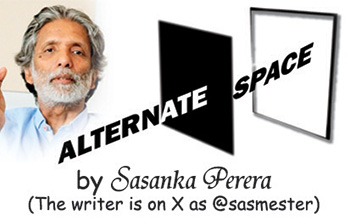 When Minister Sunil Handunnetti addressed the World Economic Forum’s ‘Is Asia’s Century at Risk?’ discussion as part of the Annual Meeting of the New Champions 2025 in June 2025, I listened carefully both to him and the questions that were posed to him by the moderator. The subsequent trolling and extremely negative reactions to his use of English were so distasteful that I opted not to comment on it at the time. The noise that followed also meant that a meaningful conversation based on that event on the utility of learning a powerful global language and how our politics on the global stage might be carried out more successfully in that language was lost on our people and pundits, barring a few commentaries.
When Minister Sunil Handunnetti addressed the World Economic Forum’s ‘Is Asia’s Century at Risk?’ discussion as part of the Annual Meeting of the New Champions 2025 in June 2025, I listened carefully both to him and the questions that were posed to him by the moderator. The subsequent trolling and extremely negative reactions to his use of English were so distasteful that I opted not to comment on it at the time. The noise that followed also meant that a meaningful conversation based on that event on the utility of learning a powerful global language and how our politics on the global stage might be carried out more successfully in that language was lost on our people and pundits, barring a few commentaries.
Now Handunnetti has reopened the conversation, this time in Sri Lanka’s parliament in November 2025, on the utility of mastering English particularly for young entrepreneurs. In his intervention, he also makes a plea not to mock his struggle at learning English given that he comes from a background which lacked the privilege to master the language in his youth. His clear intervention makes much sense.
The same ilk that ridiculed him when he spoke at WEF is laughing at him yet again on his pronunciation, incomplete sentences, claiming that he is bringing shame to the country and so on and so forth. As usual, such loud, politically motivated and retrograde critics miss the larger picture. Many of these people are also among those who cannot hold a conversation in any of the globally accepted versions of English. Moreover, their conceit about the so-called ‘correct’ use of English seems to suggest the existence of an ideal English type when it comes to pronunciation and basic articulation. I thought of writing this commentary now in a situation when the minister himself is asking for help ‘in finding a solution’ in his parliamentary speech even though his government is not known to be amenable to critical reflection from anyone who is not a party member.
The remarks at the WEF and in Sri Lanka’s parliament are very different at a fundamental level, although both are worthy of consideration – within the realm of rationality, not in the depths of vulgar emotion and political mudslinging.
The problem with Handunnetti’s remarks at WEF was not his accent or pronunciation. After all, whatever he said could be clearly understood if listened to carefully. In that sense, his use of English fulfilled one of the most fundamental roles of language – that of communication. Its lack of finesse, as a result of the speaker being someone who does not use the language professionally or personally on a regular basis, is only natural and cannot be held against him. This said, there are many issues that his remarks flagged that were mostly drowned out by the noise of his critics.
Given that Handunnetti’s communication was clear, it also showed much that was not meant to be exposed. He simply did not respond to the questions that were posed to him. More bluntly, a Sinhala speaker can describe the intervention as yanne koheda, malle pol , which literally means, when asked ‘Where are you going?’, the answer is ‘There are coconuts in the bag’.
He spoke from a prepared text which his staff must have put together for him. However, it was far off the mark from the questions that were being directly posed to him. The issue here is that his staff appears to have not had any coordination with the forum organisers to ascertain and decide on the nature of questions that would be posed to the Minister for which answers could have been provided based on both global conditions, local situations and government policy. After all, this is a senior minister of an independent country and he has the right to know and control, when possible, what he is dealing with in an international forum.
This manner of working is fairly routine in such international fora. On the one hand, it is extremely unfortunate that his staff did not do the required homework and obviously the minister himself did not follow up, demonstrating negligence, a want for common sense, preparedness and experience among all concerned. On the other hand, the government needs to have a policy on who it sends to such events. For instance, should a minister attend a certain event, or should the government be represented by an official or consultant who can speak not only fluently, but also with authority on the subject matter. That is, such speakers need to be very familiar with the global issues concerned and not mere political rhetoric aimed at local audiences.
Other than Handunnetti, I have seen, heard and also heard of how poorly our politicians, political appointees and even officials perform at international meetings (some of which are closed door) bringing ridicule and disastrous consequences to the country. None of them are, however, held responsible.
Such reflective considerations are simple yet essential and pragmatic policy matters on how the government should work in these conditions. If this had been undertaken, the WEF event might have been better handled with better global press for the government. Nevertheless, this was not only a matter of English. For one thing, Handunnetti and his staff could have requested for the availability of simultaneous translation from Sinhala to English for which pre-knowledge of questions would have been useful. This is all too common too. At the UN General Assembly in September, President Dissanayake spoke in Sinhala and made a decent presentation.
The pertinent question is this; had Handunetti had the option of talking in Sinhala, would the interaction have been any better? That is extremely doubtful, barring the fluency of language use. This is because Handunnetti, like most other politicians past and present, are good at rhetoric but not convincing where substance is concerned, particularly when it comes to global issues. It is for this reason that such leaders need competent staff and consultants, and not mere party loyalists and yes men, which is an unfortunate situation that has engulfed the whole government.
What about the speech in parliament? Again, as in the WEF event, his presentation was crystal clear and, in this instance, contextually sensible. But he did not have to make that speech in English at all when decent simultaneous translation services were available. In so far as content was concerned, he made a sound argument considering local conditions which he knows well. The minister’s argument is about the need to ensure that young entrepreneurs be taught English so that they can deal with the world and bring investments into the country, among other things. This should actually be the norm, not only for young entrepreneurs, but for all who are interested in widening their employment and investment opportunities beyond this country and in accessing knowledge for which Sinhala and Tamil alone do not suffice.
As far as I am concerned, Handunetti’s argument is important because in parliament, it can be construed as a policy prerogative. Significantly, he asked the Minister of Education to make this possible in the educational reforms that the government is contemplating.
He went further, appealing to his detractors not to mock his struggle in learning English, and instead to become part of the solution. However, in my opinion, there is no need for the Minister to carry this chip on his shoulder. Why should the minister concern himself with being mocked for poor use of English? But there is a gap that his plea should have also addressed. What prevented him from mastering English in his youth goes far deeper than the lack of a privileged upbringing.
The fact of the matter is, the facilities that were available in schools and universities to learn English were not taken seriously and were often looked down upon as kaduwa by the political spectrum he represents and nationalist elements for whom the utilitarian value of English was not self-evident. I say this with responsibility because this was a considerable part of the reality in my time as an undergraduate and also throughout the time I taught in Sri Lanka.
Much earlier in my youth, swayed by the rhetoric of Sinhala language nationalism, my own mastery of English was also delayed even though my background is vastly different from the minister. I too was mocked, when two important schools in Kandy – Trinity College and St. Anthony’s College – refused to accept me to Grade 1 as my English was wanting. This was nearly 20 years after independence. I, however, opted to move on from the blatant discrimination, and mastered the language, although I probably had better opportunities and saw the world through a vastly different lens than the minister. If the minister’s commitment was also based on these social and political realities and the role people like him had played in negating our English language training particularly in universities, his plea would have sounded far more genuine.
If both these remarks and the contexts in which they were made say something about the way we can use English in our country, it is this: On one hand, the government needs to make sure it has a pragmatic policy in place when it sends representatives to international events which takes into account both a person’s language skills and his breadth of knowledge of the subject matter. On the other hand, it needs to find a way to ensure that English is taught to everyone successfully from kindergarten to university as a tool for inclusion, knowledge and communication and not a weapon of exclusion as is often the case.
This can only bear fruit if the failures, lapses and strengths of the country’s English language teaching efforts are taken into cognizance. Lamentably, division and discrimination are still the main emotional considerations on which English is being popularly used as the trolls of the minister’s English usage have shown. It is indeed regrettable that their small-mindedness prevents them from realizing that the Brits have long lost their long undisputed ownership over the English language along with the Empire itself. It is no longer in the hands of the colonial masters. So why allow it to be wielded by a privileged few mired in misplaced notions of elitism?
Features
Finally, Mahinda Yapa sets the record straight

Clandestine visit to Speaker’s residence:
Finally, former Speaker Mahinda Yapa Abeywardena has set the record straight with regard to a controversial but never properly investigated bid to swear in him as interim President. Abeywardena has disclosed the circumstances leading to the proposal made by external powers on the morning of 13 July, 2022, amidst a large scale staged protest outside the Speaker’s official residence, situated close to Parliament.
Lastly, the former parliamentarian has revealed that it was then Indian High Commissioner, in Colombo, Gopal Baglay (May 2022 to December 2023) who asked him to accept the presidency immediately. Professor Sunanda Maddumabandara, who served as Senior Advisor (media) to President Ranil Wickremesinghe (July 2022 to September 2024), disclosed Baglay’s direct intervention in his latest work, titled ‘Aragalaye Balaya’ (Power of Aragalaya).
Prof. Maddumabandara quoted Abeywardena as having received a startling assurance that if he agreed to accept the country’s leadership, the situation would be brought under control, within 45 minutes. Baglay had assured Abeywardena that there is absolutely no harm in him succeeding President Gotabaya Rajapaksa, in view of the developing situation.
The author told the writer that only a person who had direct control over the violent protest campaign could have given such an assurance at a time when the whole country was in a flux.
One-time Vice Chancellor of the Kelaniya University, Prof. Maddumabandara, launched ‘Aragalaye Balaya’ at the Sri Lanka Foundation on 20 November. In spite of an invitation extended to former President Gotabaya Rajapaksa, the ousted leader hadn’t attended the event, though UNP leader Ranil Wickremesinghe was there. Maybe Gotabaya felt the futility of trying to expose the truth against evil forces ranged against them, who still continue to control the despicable agenda.
Obviously, the author has received the blessings of Abeywardena and Wickremesinghe to disclose a key aspect in the overall project that exploited the growing resentment of the people to engineer change of Sri Lankan leadership.
The declaration of Baglay’s intervention has contradicted claims by National Freedom Front (NFF) leader Wimal Weerawansa (Nine: The hidden story) and award-winning writer Sena Thoradeniya (Galle Face Protest: System change for anarchy) alleged that US Ambassador Julie Chung made that scandalous proposal to Speaker Abeywardena. Weerawansa and Thoradeniya launched their books on 25 April and 05 July, 2023, at the Sri Lanka Foundation and the National Library and Documentation Services Board, Independence Square, respectively. Both slipped in accusing Ambassador Chung of making an abortive bid to replace Gotabaya Rajapaksa with Mahinda Yapa Abeywardena.
Ambassador Chung categorically denied Weerawansa’s allegation soon after the launch of ‘Nine: The hidden story’ but stopped short of indicating that the proposal was made by someone else. Chung had no option but to keep quiet as she couldn’t, in response to Weerawansa’s claim, have disclosed Baglay’s intervention, under any circumstances, as India was then a full collaborator with Western designs here for its share of spoils. Weerawansa, Thoradeniya and Maddumabandara agree that Aragalaya had been a joint US-Indian project and it couldn’t have succeeded without their intervention. Let me reproduce the US Ambassador’s response to Weerawansa, who, at the time of the launch, served as an SLPP lawmaker, having contested the 2020 August parliamentary election on the SLPP ticket.
“I am disappointed that an MP has made baseless allegations and spread outright lies in a book that should be labelled ‘fiction’. For 75 years, the US [and Sri Lanka] have shared commitments to democracy, sovereignty, and prosperity – a partnership and future we continue to build together,” Chung tweeted Wednesday 26 April, evening, 24 hours after Weerawansa’s book launch.
Interestingly, Gotabaya Rajapaksa has been silent on the issue in his memoirs ‘The Conspiracy to oust me from Presidency,’ launched on 07 March, 2024.
What must be noted is that our fake Marxists, now entrenched in power, were all part and parcel of Aragalaya.
A clandestine meeting
Abeywardena should receive the appreciation of all for refusing to accept the offer made by Baglay, on behalf of India and the US. He had the courage to tell Baglay that he couldn’t accept the presidency as such a move violated the Constitution. In our post-independence history, no other politician received such an offer from foreign powers. When Baglay stepped up pressure, Abeywardena explained that he wouldn’t change his decision.
Maddumabandara, based on the observations made by Abeywardena, referred to the Indian High Commissioner entering the Speaker’s Official residence, unannounced, at a time protesters blocked the road leading to the compound. The author raised the possibility of Baglay having been in direct touch with those spearheading the high profile political project.
Clearly Abeywardena hadn’t held back anything. The former Speaker appeared to have responded to those who found fault with him for not responding to allegations, directed at him, by revealing everything to Maddumabandara, whom he described in his address, at the book launch, as a friend for over five decades.
At the time, soon after Baglay’s departure from the Speaker’s official residence, alleged co-conspirators Ven. Omalpe Sobitha, accompanied by Senior Professor of the Sinhala Faculty at the Colombo University, Ven. Agalakada Sirisumana, health sector trade union leader Ravi Kumudesh, and several Catholic priests, arrived at the Speaker’s residence where they repeated the Indian High Commissioner’s offer. Abeywardena repeated his previous response despite Sobitha Thera acting in a threatening manner towards him to accept their dirty offer. Shouldn’t they all be investigated in line with a comprehensive probe?
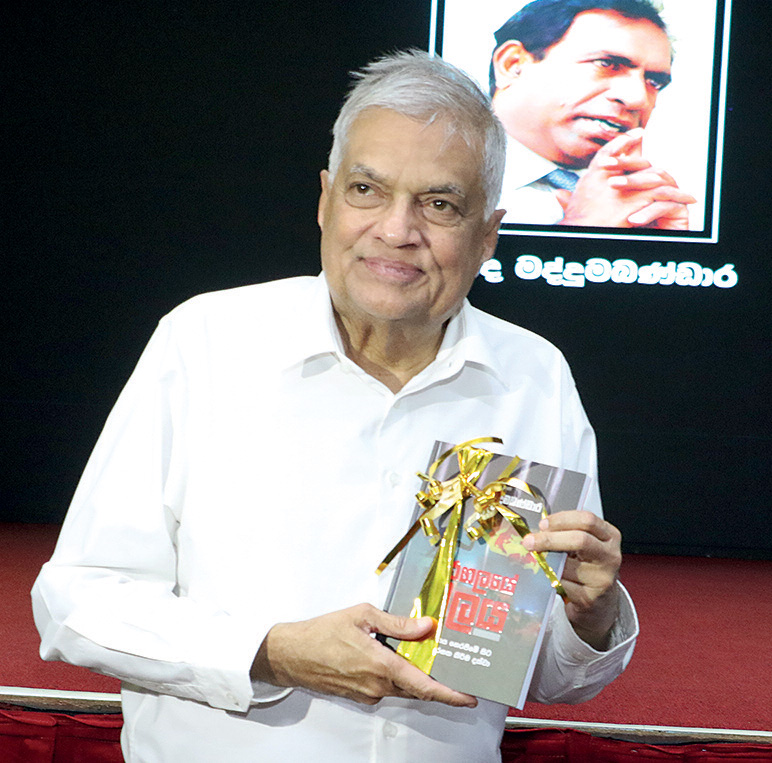
Ex-President Wickremesinghe with a copy of Aragalaye Balaya he received from its author, Prof. Professor Sunanda Maddumabandara, at the Sri Lanka Foundation recently (pic by Nishan S Priyantha)
On the basis of what Abeywardena had disclosed to him, Maddumabanadara also questioned the circumstances of the deployment of the elite Special Task Force (STF) contingent at the compound. The author asked whether that deployment, without the knowledge of the Speaker, took place with the intervention of Baglay.
Aragalaye Balaya
is a must read for those who are genuinely interested in knowing the unvarnished truth. Whatever the deficiencies and inadequacies on the part of the Gotabaya Rajapaksa administration, external powers had engineered a change of government. The writer discussed the issues that had been raised by Prof. Maddumabandara and, in response to one specific query, the author asserted that in spite of India offering support to Gotabaya Rajapaksa earlier to get Ranil Wickremesinghe elected as the President by Parliament to succeed him , the latter didn’t agree with the move. Then both the US and India agreed to bring in the Speaker as the Head of State, at least for an interim period.
If Speaker Abeywardena accepted the offer made by India, on behalf of those backing the dastardly US backed project, the country could have experienced far reaching changes and the last presidential election may not have been held in September, 2004.
After the conclusion of his extraordinary assignment in Colombo, Baglay received appointment as New Delhi’s HC in Canberra. Before Colombo, Baglay served in Indian missions in Ukraine, Russia, the United Kingdom, Nepal and Pakistan (as Deputy High Commissioner).
Baglay served in New Delhi, in the office of the Prime Minister of India, and in the Ministry of External Affairs as its spokesperson, and in various other positions related to India’s ties with her neighbours, Europe and multilateral organisations.
Wouldn’t it be interesting to examine who deceived Weerawansa and Thoradeniya who identified US Ambassador Chung as the secret visitor to the Speaker’s residence. Her high-profile role in support of the project throughout the period 31 March to end of July, 2022, obviously made her an attractive target but the fact remains it was Baglay who brought pressure on the then Speaker. Mahinda Yapa Abeywardena’s clarification has given a new twist to “Aragalaya’ and India’s diabolical role.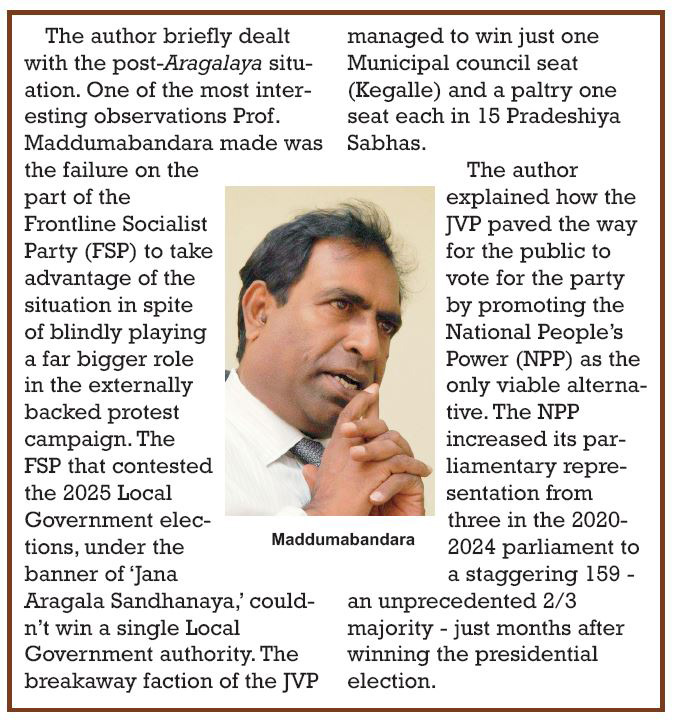
Absence of investigations
Sri Lanka never really wanted to probe the foreign backed political plot to seize power by extra-parliamentary means. Although some incidents had been investigated, the powers that be ensured that the overall project remained uninvestigated. In fact, Baglay’s name was never mentioned regarding the developments, directly or indirectly, linked to the devious political project. If not for Prof. Maddumabandara taking trouble to deal with the contentious issue of regime change, Baglay’s role may never have come to light. Ambassador Chung would have remained the target of all those who found fault with US interventions. Let me be clear, the revelation of Baglay’s clandestine meeting with the Speaker didn’t dilute the role played by the US in Gotabaya Rajapaksa’s removal.
If Prof. Maddumabandara propagated lies, both the author and Abeywardana should be appropriately dealt with. Aragalaye Balaya failed to receive the desired or anticipated public attention. Those who issue media statements at the drop of a hat conveniently refrained from commenting on the Indian role. Even Abeywardena remained silent though he could have at least set the record straight after Ambassador Chung was accused of secretly meeting the Speaker. Abeywardena could have leaked the information through media close to him. Gotabaya Rajapaksa and Ranil Wickremesinghe, too, could have done the same but all decided against revealing the truth.
A proper investigation should cover the period beginning with the declaration made by Gotabaya Rajapaksa’s government, in April 2022, regarding the unilateral decision to suspend debt repayment. But attention should be paid to the failure on the part of the government to decide against seeking assistance from the International Monetary Fund (IMF) to overcome the crisis. Those who pushed Gotabaya Rajapaksa to adopt, what they called, a domestic solution to the crisis created the environment for the ultimate collapse that paved the way for external interventions. Quite large and generous Indian assistance provided to Sri Lanka at that time should be examined against the backdrop of a larger frightening picture. In other words, India was literally running with the sheep while hunting with the hounds. Whatever the criticism directed at India over its role in regime change operation, prompt, massive and unprecedented post-Cyclone Ditwah assistance, provided by New Delhi, saved Sri Lanka. Rapid Indian response made a huge impact on Sri Lanka’s overall response after having failed to act on a specific 12 November weather alert.
It would be pertinent to mention that all governments, and the useless Parliament, never wanted the public to know the truth regarding regime change project. Prof. Maddumabandara discussed the role played by vital sections of the armed forces, lawyers and the media in the overall project that facilitated external operations to force Gotabaya Rajapaksa out of office. The author failed to question Wickremesinghe’s failure to launch a comprehensive investigation, with the backing of the SLPP, immediately after he received appointment as the President. There seems to be a tacit understanding between Wickremesinghe and the SLPP that elected him as the President not to initiate an investigation. Ideally, political parties represented in Parliament should have formed a Special Parliamentary Select Committee (PSC) to investigate the developments during 2019 to the end of 2022. Those who had moved court against the destruction of their property, during the May 2022 violence directed at the SLPP, quietly withdrew that case on the promise of a fresh comprehensive investigation. This assurance given by the Wickremesinghe government was meant to bring an end to the judicial process.
When the writer raised the need to investigate external interventions, the Human Rights Commission of Sri Lanka (HRCSL) sidestepped the issue. Shame on the so-called independent commission, which shows it is anything but independent.
Sumanthiran’s proposal
Since the eradication of the Liberation Tigers of Tamil Eelam (LTTE) in May 2009, the now defunct Tamil National Alliance’s (TNA) priority had been convincing successive governments to withdraw the armed forces/ substantially reduce their strength in the Northern and Eastern Provinces. The Illankai Thamil Arasu Kadchi (ITAK)-led TNA, as well as other Tamil political parties, Western powers, civil society, Tamil groups, based overseas, wanted the armed forces out of the N and E regions.
Abeywardena also revealed how the then ITAK lawmaker, M.A. Sumanthiran, during a tense meeting chaired by him, in Parliament, also on 13 July, 2022, proposed the withdrawal of the armed forces from the N and E for redeployment in Colombo. The author, without hesitation, alleged that the lawmaker was taking advantage of the situation to achieve their longstanding wish. The then Speaker also disclosed that Chief Opposition Whip Lakshman Kiriella and other party leaders leaving the meeting as soon as the armed forces reported the protesters smashing the first line of defence established to protect the Parliament. However, leaders of minority parties had remained unruffled as the situation continued to deteriorate and external powers stepped up efforts to get rid of both Gotabaya Rajapaksa and Ranil Wickremesinghe to pave the way for an administration loyal and subservient to them. Foreign powers seemed to have been convinced that Speaker Abeywardena was the best person to run the country, the way they wanted, or till the Aragalaya mob captured the House.
The Author referred to the role played by the media, including social media platforms, to promote Gotabaya Rajapaksa’s successor. Maddumamabandara referred to the Hindustan Times coverage to emphasise the despicable role played by a section of the media to manipulate the rapid developments that were taking place. The author also dealt with the role played by the Janatha Vimukthi Peramuna (JVP) in the project with the focus on how that party intensified its actions immediately after Gotabaya Rajapaksa stepped down.
Disputed assessment
The Author identified Ministers Bimal Rathnayaka, Sunil Handunetti and K.D. Lal Kantha as the persons who spearheaded the JVP bid to seize control of Parliament. Maddumabanda unflinchingly compared the operation, mounted against Gotabaya Rajapaksa, with the regime change operations carried out in Iraq, Libya, Egypt and Ukraine. Asserting that governments loyal to the US-led Western block had been installed in those countries, the author seemed to have wrongly assumed that external powers failed to succeed in Sri Lanka (pages 109 and 110). That assertion is utterly wrong. Perhaps, the author for some unexplained reasons accepted what took place here. Nothing can be further from the truth than the regime change operation failed (page 110) due to the actions of Gotabaya Rajapaksa, Mahinda Yapa Abeywardana and Ranil Wickremesinghe. In case, the author goes for a second print, he should seriously consider making appropriate corrections as the current dispensation pursues an agenda in consultation with the US and India.
The signing of seven Memorandums of Understanding (MoUs) with India, including one on defence, and growing political-defence-economic ties with the US, have underscored that the JVP-led National People’s Power (NPP) may not have been the first choice of the US-India combine but it is certainly acceptable to them now.
The bottom line is that a democratically elected President, and government, had been ousted through unconstitutional means and Sri Lanka meekly accepted that situation without protest. In retrospect, the political party system here has been subverted and changed to such an extent, irreparable damage has been caused to public confidence. External powers have proved that Sri Lanka can be influenced at every level, without exception, and the 2022 ‘Aragalaya’ is a case in point. The country is in such a pathetic state, political parties represented in Parliament and those waiting for an opportunity to enter the House somehow at any cost remain vulnerable to external designs and influence.
Cyclone Ditwah has worsened the situation. The country has been further weakened with no hope of early recovery. Although the death toll is much smaller compared to that of the 2004 tsunami, economic devastation is massive and possibly irreversible and irreparable.
By Shamindra Ferdinando
Features
Radiance among the Debris
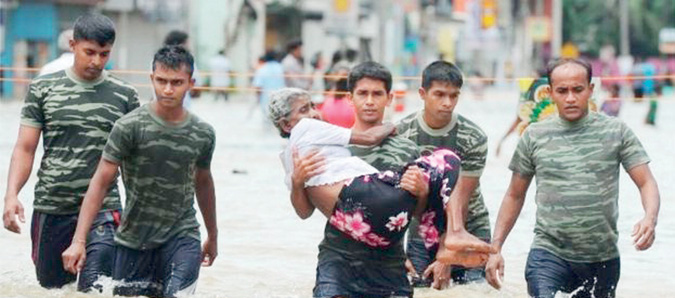
Over the desolate watery wastes,
Dulling the glow of the fabled Gem,
There opens a rainbow of opportunity,
For the peoples North and South,
To not only meet and greet,
But build a rock-solid bridge,
Of mutual help and solidarity,
As one undivided suffering flesh,
And we are moved to say urgently-
‘All you who wax so lyrically,
Of a united nation and reconciliation,
Grab this bridge-building opportunity.’
By Lynn Ockersz
-

 Features5 days ago
Features5 days agoFinally, Mahinda Yapa sets the record straight
-
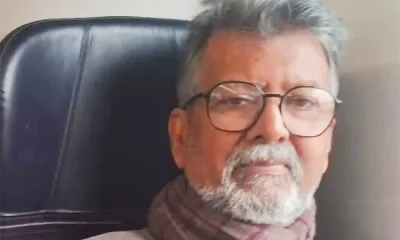
 News6 days ago
News6 days agoCyclone Ditwah leaves Sri Lanka’s biodiversity in ruins: Top scientist warns of unseen ecological disaster
-
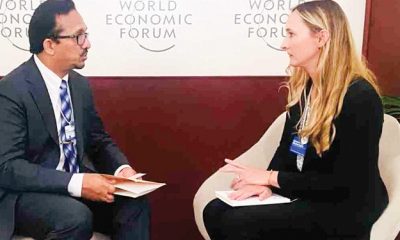
 Features5 days ago
Features5 days agoHandunnetti and Colonial Shackles of English in Sri Lanka
-
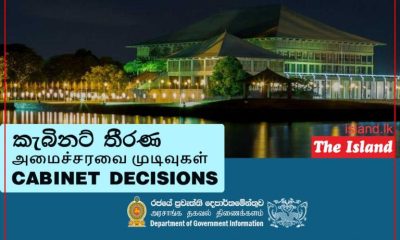
 Business4 days ago
Business4 days agoCabinet approves establishment of two 50 MW wind power stations in Mullikulum, Mannar region
-

 News7 days ago
News7 days agoJetstar to launch Australia’s only low-cost direct flights to Sri Lanka, with fares from just $315^
-
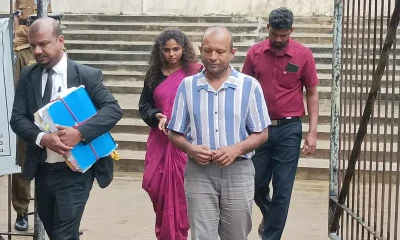
 News4 days ago
News4 days agoGota ordered to give court evidence of life threats
-
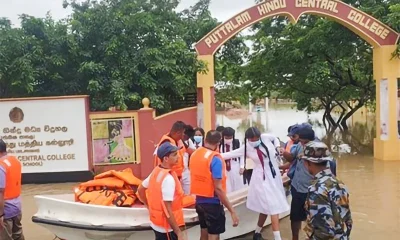
 Features6 days ago
Features6 days agoAn awakening: Revisiting education policy after Cyclone Ditwah
-

 Features4 days ago
Features4 days agoCliff and Hank recreate golden era of ‘The Young Ones’













